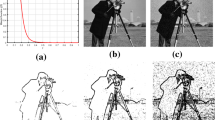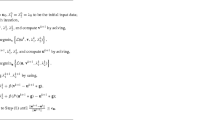Abstract
Image denoising is an essential step in the image processing task. The first-order variational model can remove noise while preserving edges, but it also generates the staircase effect. Although the bounded Hessian regulariser can reduce this side effect, it tends to blur object edges. In this paper, we propose a corner-weighted bounded Hessian model (CWBH) for image denoising, which has capability of removing noise without causing blurring object edges and artifacts. The bounded Hessian regularization at each pixel is controlled by a weight function which has an exponential form and depends on the corner response of the pixel. The split Bregman algorithm is adapted to decompose the proposed minimization problem into several subproblems which are solved directly using fast Fourier transform and the shrinkage operators. The proposed model is evaluated on synthetic and real noisy images for both spatially invariant and variant additive white Gaussian noise (AWGN). Extensive experiments demonstrate that our proposed model outperforms some state-of-the-art variational models for various types of noise and images. For uniform AWGN, CWBH surpasses other models on average by 0.014 for SSIM and by 0.77dB for PSNR; for spatially variant AWGN, these figures are 0.033 and 0.89dB, respectively.











Similar content being viewed by others
References
Bansal M, Kumar M, Kumar M (2021) 2D object recognition techniques: State-of-the-art work. Archives of Computational Methods in Engineering, 28(3):1147–1161
Bansal M, Kumar M, Kumar M, Kumar K (2021) An efficient technique for object recognition using shi-tomasi corner detection algorithm. Soft Comput 25(6):4423–4432
Bredies K, Kunisch K, Pock T (2010) Total generalized variation. SIAM Journal on Imaging Sciences 3(3):492–526
Calatroni L, Papafitsoros K (2019) Analysis and automatic parameter selection of a variational model for mixed gaussian and salt-and-pepper noise removal. Inverse Problems 35(11):114001
Chan TF, Esedoglu S, Park F (2010) A fourth order dual method for staircase reduction in texture extraction and image restoration problems. In: 2010 IEEE International conference on image processing, IEEE, pp 4137–4140
Chan RH, Liang H, Wei S, Nikolova M, Tai X-C (2015) High-order total variation regularization approach for axially symmetric object tomography from a single radiograph. Inverse Problems & Imaging 9(1):55
Duan J, Qiu Z, Lu W, Wang G, Pan Z, Bai L (2016) An edge-weighted second order variational model for image decomposition. Digital Signal Process 49:162–181
Duan J, Ward WO, Sibbett L, Pan Z, Bai L (2017) Introducing diffusion tensor to high order variational model for image reconstruction. Digital Signal Process 69:323–336
Garg D, Garg NK, Kumar M (2018) Underwater image enhancement using blending of clahe and percentile methodologies. Multimedia Tools and Applications 77(20):26545–26561
Getreuer P (2012) Rudin-osher-fatemi total variation denoising using split bregman. Image Process Line 2:74–95
Glowinski R, Pan T-W, Tai X-C (2016) Some facts about operator-splitting and alternating direction methods. In: Splitting methods in communication, imaging, science, and engineering, Springer, pp 19–94
Goldluecke B, Cremers D (2011) Introducing total curvature for image processing. In: 2011 International conference on computer vision, IEEE, pp 1267–1274
Goldstein T, Osher S (2009) The split bregman method for l1-regularized problems. SIAM Journal on Imaging Sciences 2(2):323–343
Harris C, Stephens M, et al. (1988) A combined corner and edge detector. Alvey Vision Conference 15:10–5244. citeseer
Hintermüller M, Holler M, Papafitsoros K (2018) A function space framework for structural total variation regularization with applications in inverse problems. Inverse Problems 34(6):064002
Kumar M, Jindal MK, Sharma RK, Jindal SR (2020) Performance evaluation of classifiers for the recognition of offline handwritten gurmukhi characters and numerals: A study. Artif Intell Rev 53(3):2075–2097
Kumar A, Kumar M, Kaur A (2021) Face detection in still images under occlusion and non-uniform illumination. Multimedia Tools and Applications 80 (10):14565–14590
Lebrun M, Colom M, Morel J-M (2015) The noise clinic: a blind image denoising algorithm. Image Process Line 5:1–54
Liu C, Chen L-C, Schroff F, Adam H, Hua W, Yuille AL, Fei-Fei L (2019) Auto-deeplab: Hierarchical neural architecture search for semantic image segmentation. In: Proceedings of the IEEE/CVF conference on computer vision and pattern recognition, pp 82–92
Lu W, Duan J, Qiu Z, Pan Z, Liu RW, Bai L (2016) Implementation of high-order variational models made easy for image processing. Mathematical Methods in the Applied Sciences 39(14):4208–4233
Milanfar P (2012) A tour of modern image filtering: New insights and methods, both practical and theoretical. IEEE Signal Process Mag 30(1):106–128
Minaee S, Boykov YY, Porikli F, Plaza AJ, Kehtarnavaz N, Terzopoulos D (2021) Image segmentation using deep learning: A survey. IEEE Transactions on Pattern Analysis and Machine Intelligence
Papafitsoros K, Schoenlieb CB, Sengul B (2013) Combined first and second order total variation inpainting using split bregman. Image Processing On Line
Papafitsoros K, Schönlieb C-B (2014) A combined first and second order variational approach for image reconstruction. Journal of Mathematical Imaging and Vision 48(2):308–338
Pham CT, Tran TTT, Gamard G (2020) An efficient total variation minimization method for image restoration. Informatica 31(3):539–560
Phan TDK (2018) A triangle mesh-based corner detection algorithm for catadioptric images. The Imaging Science Journal 66(4):220–230
Phan TDK (2020) A weighted total variation based image denoising model using mean curvature. Optik 217:164940
Phan TDK, Tran THY (2020) A space-variant nonlinear algorithm for denoising omnidirectional images corrupted by poisson noise. IEEE Signal Process Lett 27:535–539
Prasath VS, Vorotnikov D, Pelapur R, Jose S, Seetharaman G, Palaniappan K (2015) Multiscale tikhonov-total variation image restoration using spatially varying edge coherence exponent. IEEE Trans Image Process 24(12):5220–5235
Rudin LI, Osher S, Fatemi E (1992) Nonlinear total variation based noise removal algorithms. Physica D: Nonlinear Phenomena 60(1-4):259–268
Setiadi DRIM (2021) Psnr vs ssim: imperceptibility quality assessment for image steganography. Multimedia Tools and Applications 80:8423–8444
Thang PC, Thao TTT, Khoa PTD, Sang DV, Tuan PM, Hieu NM (2019) An adaptive algorithm for restoring image corrupted by mixed noise. Cybernetics and Physics 8(2):73–82
Tian C, Xu Y, Fei L, Yan K (2018) Deep learning for image denoising: a survey. In: International conference on genetic and evolutionary computing, Springer, pp 563–572
Tian C, Xu Y, Li Z, Zuo W, Fei L, Liu H (2020) Attention-guided cnn for image denoising. Neural Netw 124:117–129
Wang Z, Bovik AC, Sheikh HR, Simoncelli EP (2004) Image quality assessment: from error visibility to structural similarity. IEEE Trans Image Process 13(4):600–612
Yan J, Lu W-S (2015) Image denoising by generalized total variation regularization and least squares fidelity. Multidim Syst Sign Process 26(1):243–266
Zhang K, Zuo W, Chen Y, Meng D, Zhang L (2017) Beyond a gaussian denoiser: Residual learning of deep cnn for image denoising. IEEE Trans Image Process 26(7):3142–3155
Zhang K, Zuo W, Zhang L (2018) Ffdnet: Toward a fast and flexible solution for cnn-based image denoising. IEEE Trans Image Process 27(9):4608–4622
Zhou Z, Siddiquee MMR, Tajbakhsh N, Liang J (2018) Unet++: A nested u-net architecture for medical image segmentation. In: Deep learning in medical image analysis and multimodal learning for clinical decision support, Springer, pp 3–11
Zhu W, Chan T (2012) Image denoising using mean curvature of image surface. SIAM Journal on Imaging Sciences 5(1):1–32
Zhu W, Tai X-C, Chan T (2013) Augmented lagrangian method for a mean curvature based image denoising model. Inverse Problems & Imaging 7(4):1409
Acknowledgements
This research is funded by Funds for Science and Technology Development of the University of Danang under project number B2020-DN02-79.
Author information
Authors and Affiliations
Corresponding author
Additional information
Publisher’s note
Springer Nature remains neutral with regard to jurisdictional claims in published maps and institutional affiliations.
Appendix: Discretisation scheme
Appendix: Discretisation scheme
In this section, we describe the discretisation schemes for differential operators and norms. For more details, we refer the reader to [20, 23, 24]. In this paper, we use the periodic boundary condition for operators so that the FFT can be applied to solve the u-subproblem (17) efficiently. To define the discrete forms of differential operators, we first provide the forward and the backward difference operators.
where \(u \in \mathbb {R}^{N\times M}\).
The first, second, and fourth order differential operators are expressed as follows. For simplicity, we do not list the boundary conditions.
-
the gradient operator:
$$ \nabla u = \left( D_{x}^{+} u_{i,j}, D_{y}^{+} u_{i,j} \right), $$(37) -
the divergence operator is defined by analogy with the continuous case by −div(p) ⋅ u = p ⋅∇u, where \(p \in \left (\mathbb {R}^{N\times M}\right )^{2}\) and “⋅” denotes the Euclidean inner product:
$$ \text{div}(p)_{i,j}= D_{x}^{-} \left( p_{1} \right)_{i,j}+ D_{y}^{-} \left( p_{2} \right)_{i,j}. $$(38) -
the Laplace operator:
$$ {\varDelta} u_{i,j} = \text{div}(\nabla u)_{i,j} = D_{x}^{+} D_{x}^{-} u_{i,j} + D_{y}^{-} D_{y}^{+} u_{i,j}. $$(39) -
the second-order operator \(\text {div}^{2}: \left (\mathbb {R}^{N\times M} \right )^{2} \rightarrow \mathbb {R}^{N\times M}\) is related to the Hessian operator via the adjointness property as div2(q) ⋅ u = q ⋅∇2u, where \(q \in \left (\mathbb {R}^{N\times M}\right )^{4}\):
$$ \text{div}^{2} (q)_{i,j} = D_{x}^{-} D_{x}^{+} q_{1_{i,j}} + D_{y}^{-} D_{x}^{-} q_{2_{i,j}} + D_{x}^{-} D_{y}^{-} q_{3_{i,j}} + D_{y}^{+} D_{y}^{-} q_{4_{i,j}}. $$(40) -
the Hessian operator:
$$ \nabla^{2} u_{i,j} = \begin{pmatrix} D_{x}^{-} D_{x}^{+} u_{i,j} & D_{y}^{+} D_{x}^{+} u_{i,j} \\ D_{x}^{+} D_{y}^{+} u_{i,j} & D_{y}^{-} D_{y}^{+} u_{i,j} \end{pmatrix}. $$(41) -
the fourth-order differential operator:
$$ \begin{array}{ll} \text{div}^{2} \left( \nabla^{2} u\right)_{i,j} = & D_{x}^{+} D_{x}^{-} D_{x}^{-} D_{x}^{+} u_{i,j} + D_{y}^{-} D_{x}^{-} D_{y}^{+} D_{x}^{+} u_{i,j}\\ & + D_{x}^{-} D_{y}^{-} D_{x}^{+} D_{y}^{+} u_{i,j} + D_{y}^{+} D_{y}^{-} D_{y}^{-} D_{y}^{+} u_{i,j}. \end{array} $$(42)
By applying the forward and backward difference operators (35), (36) to differential operators (37)–(42), one can obtain final formulas.
The L1 and L2 norms are defined as
where \(\omega \in (\mathbb {R}^{N\times M})^{K}\).
Rights and permissions
About this article
Cite this article
Phan, T.D.K. A corner-weighted bounded Hessian model for image denoising. Multimed Tools Appl 81, 25557–25580 (2022). https://doi.org/10.1007/s11042-021-11800-4
Received:
Revised:
Accepted:
Published:
Issue Date:
DOI: https://doi.org/10.1007/s11042-021-11800-4




